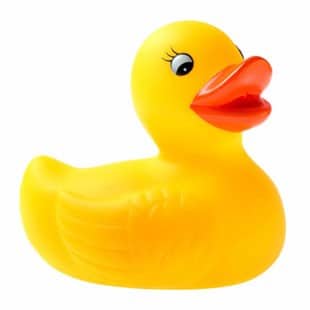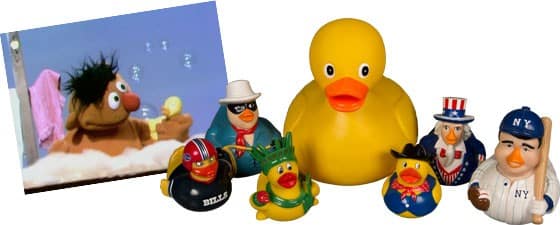Cultural Analysis: Rubber Duckie: Put It Down and Pick It Up


(The Strong)
A classic rubber duck is approximately 1.5 inches high by 2.5 inches wide. The one who sits on my bathroom counter is yellow, with an orange beak, black and white eyes, and three eyelashes per eye. Though they’re known as rubber ducks, according to The Strong National Museum of Play, these days, “the iconic floating yellow figure with bright orange bill” is typically made of vinyl. The Strong calls rubber ducks “the quintessential bathtub toy” that appeals to kids and adults alike through “good clean fun.” With their cheerful, colorful appearances inspired by ducklings (the only yellow ducks), the ubiquitous rubber ducks make fun companions for bathing kids and provide simple, infinitely-personalizable kitsch for adults.
“Good clean fun” represents the theme of The Strong’s entry on rubber ducks; it’s part of a series on the museum’s website for The National Toy Hall of Fame. Rubber ducks’ inclusion in the series indicates the ubiquity of these bath toys, but the website also provides a history for the object, demonstrating their cultural significance—something that would be easy to overlook for objects that are so popular they get taken for granted as fixtures in our everyday lives (and bathrooms). Both the museum exhibit and the entry on rubber ducks will appeal to adults interested in children’s culture who want to learn the unique history of childhood icons.
While The Strong National Museum of Play and The National Toy Hall of Fame add credibility to the information about rubber ducks, the entry also references Ernie’s famous “Rubber Duckie” song that debuted on Sesame Street in 1970 (The Strong). If audience members don’t yet have the song stuck in their heads, the familiar, wholesome appeal of a show like Sesame Street and the lovable Muppet character Ernie are likely to inspire trust. That ethos is supported by examples of logos throughout the entry. The Strong traces the history of the rubber duck, from its inception in “the late 1800s” to its “iconic” form in the 1940s to the Sesame Street song that reached number 16 on the Billboard charts to its inclusion in the museum in 2013. These examples of logos demonstrate the longevity of the rubber duck as well as their enduring, unchanging image for decades. Perhaps the popularity of the rubber duck lies in its simplicity—a universal, happy character beloved by generations.
Certainly The Strong entry reveals a number of values rubber ducks embody. As a bath toy, the rubber duck promotes healthy child development as it “develops muscle strength and coordination” (The Strong). They also “sharpen toddlers’ senses” (The Strong). In further pursuit of healthy children (a value emphasized by the museum entry), rubber ducks provide calm education about personal hygiene; as The Strong says, “[t] heir presence in the bathtub soothes youngsters’ fears of water and water immersion and makes good clean fun of the routine hygiene they’re learning.” And, since they’re toys, rubber ducks are also supposed to be fun and inspire play. Making a reference to the Sesame Street song, The Strong writes that “kids still sing the praises of their water play pals.” I think the big-eyed, duckling-hued toys continue to appeal to kids because they’re cute and happy; they draw on children’s love of animals and allow kids in the bath to mimic the actions of real ducks, animals typically seen as familiar and endearing. By making the ducks look like ducklings, there’s a sense of neoteny that promotes playfulness and care for kids and adults.
Adults love rubber ducks, too, The Strong assures its audience, as “[c]ollectors proudly display variations of the classic form that proclaim their affinity to colleges, careers, sports, celebrities, and holidays. Aficionados adorn their homes with rubber duck–themed shower curtains, towels, bathrobes, nightlights, and wallpaper.” Maybe rubber ducks appeal to so many adults because they recall a simpler time of being loved and cared for in the bath, or of taking care of beloved children. So, the next time you notice a rubber duck smiling in the bathroom, remember, it’s not really rubber and it’s not just a duck. It’s a symbol of childhood: happy, healthy, simple, and filled with wonder at everyday objects like a yellow toy duck.
In “Rubber Ducks and Their Significance in Contemporary American Culture,” Lottie Larsen Meyer explores the symbolism of rubber ducks as definitive of childhood—at least post-World War II childhood in the United States, where indoor plumbing is assumed and bath time serves as a universal and daily childhood ritual. Meyer’s definition of childhood, as embodied by rubber ducks, emphasizes a fusion of practical and pleasant: “the so-called ‘fun morality’ child-rearing philosophy, which emerged in the 1960s, has contributed substantially to the duck’s popularity. The philosophy influenced not only parents, but also provoked educators and organizations, such as the Children’s Television Workshop which produced Sesame Street, to inject ‘fun’ into learning” (Meyer 14). Ultimately, rubber ducks define the inherent tension within childhood, where children must be always learning (but having fun doing it) and adults burned out from work want to recover childhood pleasure that never quite exited. Rubber ducks, then, define childhood as development tempered with toys and adulthood as the continual quest for childhood innocence.
As bath toys, rubber ducks are fundamentally teaching toys. They arise, according to Meyer, out of common childhood fears about water: “[m]any children experience bath fears between birth and 2 years. Anxieties arise over the possibility of being sucked down the drain or drowning, water temperature, being in an enclosed space, shampoo in the eyes, and the loud noise of water gushing out the faucet” (Meyer 15). Some of these fears are more realistic than others, but regardless of the validity of the anxieties, children require baths and instruction in personal hygiene.
Rubber ducks, then, address children’s fears not through avoidance but through play, by providing a water-loving friend (and distraction) to entice children into the tub. According to Meyer, rubber ducks fit with other bath toys and accessories for children as teaching toys (16); children “squeeze the ducks, swim them through bubble bath, and pour water over them, their play and adventure lessen their fears, making the bathing process more enjoyable” (Meyer 16). Rubber ducks define childhood as essential work; there are skills children need to learn, like how to care for their bodies, but also the paradox that we always want work to be pleasant. It’s educational, but it’s always (supposed to be) fun.
Rubber ducks appeal to adults, immersed in the world of work, perhaps because the teaching toys remind of a time when learning was always fun and someone else was responsible for soothing and caring for us. Adults who enjoy images of rubber ducks seem to forget the fears and anxieties the toys are intended to alleviate. Instead, adults associate rubber ducks with the illusory purity and innocence of childhood. Meyer suggests “[s]wimming in water, a cleansing and purifying agent, and being played with by cute, innocent infants, and toddlers, [rubber ducks] have no negative associations. Perhaps the qualities our culture values in childhood rub off on the rubber duck, or the cute yellow duck epitomizes those values” (20). For children, rubber ducks are teaching toys, but for adults, rubber ducks promote nostalgia—the simplicity, wholesome pleasure, and goodness of childhood that are not present in the adult world.
Rubber ducks are pleasurable and popular for adults and children because they represent purity, play, and protection. They require children to face their fears, but in an environment that’s soothing and safe; it’s work, but it’s not just work. Even adults get to play while tending children in the bath (Meyer 20). It’s play, but it’s not just child’s play. Rubber ducks define childhood as not lost, not over, but as something recoverable. Meyer asserts that “[a]dults may also desire to bring out a dimension of themselves hidden by adult maturation and societal norms: the inner self” and “the inner child” (22). With rubber ducks, childhood is work and adulthood is play, but the two stages are not so separate either. For adults who work with children as educators and/or parents, collectors, childhood culture critics, designers, and marketers, rubber ducks symbolize the pleasurable work of facing childhood fears in the bath as well as adult fears of growing up.
In 1986, Sesame Street addressed the tension between play and work, childhood and adulthood, with a new song called “Put Down the Duckie” (“Put Down the Duckie”). Within the song, Ernie works with Hoots the Owl (and, in some versions, an extensive celebrity cast) because he wants to learn to play the saxophone but can’t do that while holding onto his rubber duck (“Put Down the Duckie”). Muppet Wiki cites the inspiration for the song as coming from the Institute for Health Realities, which references Ernie and his beloved rubber duck: “[t]he Duckie represents our old habits—which have become habits because they’re what make us comfortable. To move forward in life, we have to put down our Duckies—or lay aside our old habits. Ernie learns it’s the first step for him, and it is as well for the rest of us” (“Put Down the Duckie”). The chorus of the song instructs Ernie “You’ve gotta put down the duckie/Put down the duckie/Put down the duckie/If you wanna play the saxophone” (The Electric Company). That repetition represents the struggle Ernie (and, perhaps, the audience) faces in wanting to hold onto the comforts of childhood but also desiring the pleasures of adulthood. Rubber ducks can teach children to face their fears of water, yet in Ernie’s case, the familiarity of the rubber duck prevents him from doing the work to learn a more grown-up skill.
By the end of the song, Ernie manages to put down the duck and play the saxophone; the duck is no longer the “problem” (The Electric Company). Once he’s done playing, Ernie can, of course, pick the duck back up, but he’s no longer dependent on it in a way that stunts his growth. In this sense, the rubber duck still symbolizes the work of growing up—and insists that such labor can even be fun. Audiences can view rubber ducks and look at the specific example of the song “Put Down the Duckie” to appreciate that childhood and adulthood aren’t totally separate or different. There are fears in childhood that must be faced in order to grow up, but there are pleasures of childhood that should be maintained too. There’s a time to put down the duckie, but there’s also a time to pick it up again.
Works Cited
The Electric Company. “Put Down the Duckie.” Put Down the Duckie (Song). Muppet
Wiki. https://muppet.fandom.com/wiki/Put_Down_the_Duckie_(song). Accessed 25 July 2019.
Meyer, Lottie Larsen. “Rubber Ducks and Their Significance in Contemporary American
Culture.” The Journal of American Culture, 29.1, 2006, pp. 14-23.
“Put Down the Duckie.” Muppet Wiki.
https://muppet.fandom.com/wiki/Put_Down_the_Duckie_(song). Accessed 25 July 2019.
The Strong National Museum of Play. “Rubber Duck.” The National Toy Hall of Fame,
2013, www.toyhalloffame.org/toys/rubber-duck. Accessed 23 July 2019.
